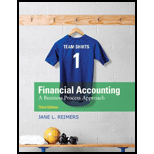
Financial Accounting
3rd Edition
ISBN: 9780133791129
Author: Jane L. Reimers
Publisher: Pearson Higher Ed
expand_more
expand_more
format_list_bulleted
Question
Chapter 5, Problem 2MCQ
To determine
Ascertain the amount of ending inventory using FIFO cost flow method.
Expert Solution & Answer
Want to see the full answer?
Check out a sample textbook solution
Students have asked these similar questions
Hi expert please give me answer general accounting question
What was the direct labor cost variance?
Financial accounting
Chapter 5 Solutions
Financial Accounting
Ch. 5 - In each separate situation, identify which company...Ch. 5 - Prob. 2YTCh. 5 - Prob. 3YTCh. 5 - Prob. 4YTCh. 5 - Prob. 5YTCh. 5 - Jaynes Jewelry Store purchased three diamond and...Ch. 5 - Prob. 7YTCh. 5 - Prob. 8YTCh. 5 - Prob. 9YTCh. 5 - Prob. 1Q
Ch. 5 - What is the difference between freight-in and...Ch. 5 - What is the difference between a purchase return...Ch. 5 - What is a purchase discount? What is the effect of...Ch. 5 - Prob. 5QCh. 5 - Prob. 6QCh. 5 - Prob. 7QCh. 5 - What is the difference between a periodic and...Ch. 5 - What is inventory shrinkage?Ch. 5 - What is the difference between the physical flow...Ch. 5 - What are the common cost flow methods for...Ch. 5 - If inventory costs are rising, which method (FIFO,...Ch. 5 - If inventory costs are rising, which method (FIFO,...Ch. 5 - Does LIFO or FIFO give the bestmost currentbalance...Ch. 5 - How do taxes affect the choice between LIFO and...Ch. 5 - Does the periodic or perpetual choice affect the...Ch. 5 - What is the lower-of-cost-or-market rule and why...Ch. 5 - What does the gross profit percentage measure? How...Ch. 5 - What does the inventory turnover ratio measure?...Ch. 5 - What are some of the risks associated with...Ch. 5 - Prob. 1MCQCh. 5 - Prob. 2MCQCh. 5 - Prob. 3MCQCh. 5 - Prob. 4MCQCh. 5 - Prob. 5MCQCh. 5 - Prob. 6MCQCh. 5 - Prob. 7MCQCh. 5 - Prob. 8MCQCh. 5 - Prob. 9MCQCh. 5 - Prob. 10MCQCh. 5 - Prob. 1SEACh. 5 - Prob. 2SEACh. 5 - Prob. 3SEACh. 5 - Prob. 4SEACh. 5 - Prob. 5SEACh. 5 - Prob. 6SEACh. 5 - Prob. 7SEACh. 5 - Prob. 8SEACh. 5 - The following information pertains to item #007SS...Ch. 5 - Prob. 10SEACh. 5 - Prob. 11SEBCh. 5 - Prob. 12SEBCh. 5 - Prob. 13SEBCh. 5 - Prob. 14SEBCh. 5 - Prob. 15SEBCh. 5 - Prob. 16SEBCh. 5 - Prob. 17SEBCh. 5 - Given the following information, calculate the...Ch. 5 - Prob. 19SEBCh. 5 - Prob. 20SEBCh. 5 - Prob. 21EACh. 5 - Prob. 22EACh. 5 - Prob. 23EACh. 5 - Prob. 24EACh. 5 - August 11Purchased four units at 400 each August...Ch. 5 - Prob. 26EACh. 5 - Prob. 27EACh. 5 - Prob. 28EACh. 5 - Prob. 29EACh. 5 - Prob. 30EACh. 5 - Given the following information, calculate the...Ch. 5 - Prob. 32EBCh. 5 - Prob. 33EBCh. 5 - Prob. 34EBCh. 5 - Prob. 35EBCh. 5 - Prob. 36EBCh. 5 - Prob. 37EBCh. 5 - Assume Radio Tech uses a perpetual inventory...Ch. 5 - Prob. 39EBCh. 5 - Prob. 40EBCh. 5 - Prob. 41EBCh. 5 - Prob. 42EBCh. 5 - Prob. 43PACh. 5 - Prob. 44PACh. 5 - Prob. 45PACh. 5 - The following transactions occurred during July...Ch. 5 - Prob. 47PACh. 5 - Prob. 48PACh. 5 - Calculate cost of goods sold and ending inventory;...Ch. 5 - Prob. 50PACh. 5 - Green Bay Cheese Company is considering changing...Ch. 5 - The following information is for Leos Solar...Ch. 5 - Prob. 53PACh. 5 - Prob. 54PBCh. 5 - Prob. 55PBCh. 5 - Prob. 56PBCh. 5 - Prob. 57PBCh. 5 - Prob. 58PBCh. 5 - Prob. 59PBCh. 5 - Calculate cost of goods sold and ending inventory;...Ch. 5 - Prob. 61PBCh. 5 - Castana Company is considering changing inventory...Ch. 5 - The following information is for Falling Numbers...Ch. 5 - Prob. 64PBCh. 5 - Prob. 1FSACh. 5 - Prob. 2FSACh. 5 - Prob. 3FSACh. 5 - Prob. 1CTPCh. 5 - Prob. 2CTP
Knowledge Booster
Learn more about
Need a deep-dive on the concept behind this application? Look no further. Learn more about this topic, accounting and related others by exploring similar questions and additional content below.Similar questions
arrow_back_ios
SEE MORE QUESTIONS
arrow_forward_ios
Recommended textbooks for you
- Principles of Accounting Volume 1AccountingISBN:9781947172685Author:OpenStaxPublisher:OpenStax College
 Cornerstones of Financial AccountingAccountingISBN:9781337690881Author:Jay Rich, Jeff JonesPublisher:Cengage Learning
Cornerstones of Financial AccountingAccountingISBN:9781337690881Author:Jay Rich, Jeff JonesPublisher:Cengage Learning - Century 21 Accounting Multicolumn JournalAccountingISBN:9781337679503Author:GilbertsonPublisher:Cengage
 Intermediate Accounting: Reporting And AnalysisAccountingISBN:9781337788281Author:James M. Wahlen, Jefferson P. Jones, Donald PagachPublisher:Cengage Learning
Intermediate Accounting: Reporting And AnalysisAccountingISBN:9781337788281Author:James M. Wahlen, Jefferson P. Jones, Donald PagachPublisher:Cengage Learning

Principles of Accounting Volume 1
Accounting
ISBN:9781947172685
Author:OpenStax
Publisher:OpenStax College

Cornerstones of Financial Accounting
Accounting
ISBN:9781337690881
Author:Jay Rich, Jeff Jones
Publisher:Cengage Learning



Century 21 Accounting Multicolumn Journal
Accounting
ISBN:9781337679503
Author:Gilbertson
Publisher:Cengage

Intermediate Accounting: Reporting And Analysis
Accounting
ISBN:9781337788281
Author:James M. Wahlen, Jefferson P. Jones, Donald Pagach
Publisher:Cengage Learning
IAS 29 Financial Reporting in Hyperinflationary Economies: Summary 2021; Author: Silvia of CPDbox;https://www.youtube.com/watch?v=55luVuTYLY8;License: Standard Youtube License